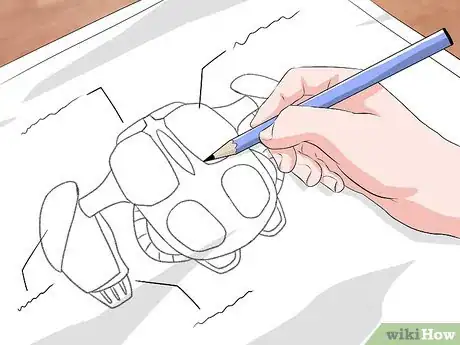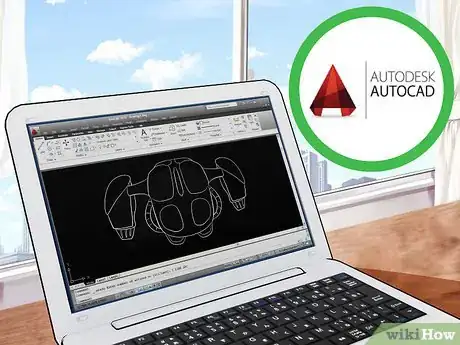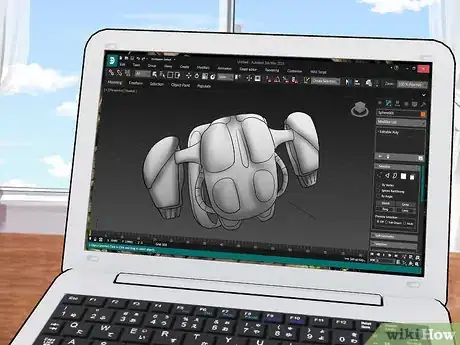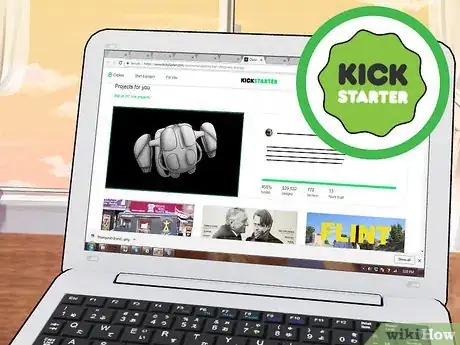This article was co-authored by Jeremy Rutman, PhD. Dr. Jeremy Rutman is a Patent Attorney and the CEO and Founder of RutmanIP, a boutique intellectual property firm in Israel. With over 15 years of experience, Dr. Rutman specializes in drafting patent applications in various fields such as physics, computer hardware and software, electrical engineering, mechanical engineering, green energy, and software. He holds a BS degree in Physics from Harvard University, where he graduated cum laude, and an MS and Ph.D. in Physics from the Technion - Israel Institute of Technology. Dr. Rutman has extensive experience turning start-up ideas into strategic assets and has published his work in many leading professional journals in the field.
wikiHow marks an article as reader-approved once it receives enough positive feedback. This article has 11 testimonials from our readers, earning it our reader-approved status.
This article has been viewed 261,384 times.
Getting a prototype made for your product is a necessary step between design and production. Before you can start production and convince people to buy your product, you will need to refine your design and present a working model. Basic prototypes can be made with household materials, but there are also plenty of machine shops, 3D printing firms, and other places that can build you a prototype in a short amount of time. To get your prototype made, present a thought-out design and find a company that’s right for you.
Steps
Designing Your Product
-
1Take apart competing products. Unless you’ve come up with something original, your product is going to have competitors in the market. Get those products and disassemble them. If you’re building a jetpack, unscrew a competing jetpack. Look at the materials used and how you can save time and improve upon your design.
- Similarly, for electronic products such as websites or applications, dig into the coding. Find out the ways you can improve the product to make yours more successful.
- Don’t copy someone else’s design, or else you’ll get sued. Incorporate what you learn to refine your own design.
-
2Make a sketch of your product. Write or type out your product’s ideas on a piece of paper. Draw what your product will look like, if you can. This will give you a rough idea of how the first prototype will look and allow you catch flaws and ways to improve the design before you invest in building a prototype.
- Use the sketch to decide upon what features are necessary to your design. Choose the few features that allow your design to function and limit the amount of costly extras, such as painting and adding voice commands to your robot vacuum design.
Advertisement -
3Obtain a computer-aided design (CAD) of your prototype. CAD requires specialized training, so a professional can help you with this. The computer design is much more detailed than your initial sketch. This is the design you will give to the prototype maker in order to get the most clear and detailed idea of your product. If your product isn’t something you’ll be able to make at home on your own, you’ll need this.
- Be sure to check the credentials of your designer as well as their cost per hour. Ask for examples of their work and possibly credentials from a certified CAD school program.
-
4Create a handmade version of your design. The first example of your prototype may be made at home and can be made in miniature to save money. Physical products can be made with whatever you have laying around your house, such as making your leather handbag design out of some nylon clothing you’re not using. Having a sample design of your product makes it easier to explain to prototype designers and investors and will give you another chance to refine your design.[1]
- At this point, the design doesn’t need to be perfect. This handmade design only needs to be presentable, showing that your idea is possible.
- Using alternate material from your original design forces you to test your idea and consider why you made it the way you did. You may even find that the nylon works better than the leather for your handbag.
- For physical products, choose a cheap modeling product such as Shapelock, which when treated with heat can be molded like clay.
- For electronic products, search for third-party programming libraries in order to save time on coding and image design. Fill in these parts later.
-
5Use a modeling program. While making a physical design by hand is an option, thanks to technology, you can use computer software to make a digital prototype. Various types of software take your idea, either drawn out on paper or inside the software itself, and turn it into a 3D, interactive design at less time and cost than making it yourself or hiring help.[2]
- Programs such as Prototyping on Paper and InVision let you upload designs and make interactive models to mimic how customers will handle your product.
- Try programs such as Dribbble and Freebiesbug to buy user interfaces for mobile applications in order to save time or money spent on a designer.
- Use a program such as Skala Preview to monitor changes you make to your design as you work.
Building Your Prototype
-
1Find prototype makers that fit your budget. Prototype-making involves molding, assembly, and labor costs. Traditionally, making a prototype gets somewhat expensive. Settle upon the material you want to use for your prototype, which should be the same as what you want to use in the final product. Speak to representatives at companies and check their costs and credentials.
- Professional designers can be located on free sites such as thomasnet.com.
- You may also be able to someone who can make your prototype cheaper, such as a student from a local university.
-
2Protect your design. As you consult with prototype companies, ask about their credentials and past work to ensure that the prototype will be quality and true to your design.[3] Even if the company you choose has worked well with its customers in the past, get a non-disclosure agreement from the company or designer before you hire them, unless you already have a patent.
- The more professional the prototype looks, the easier it will be to sell to prospective buyers.
- The non-disclosure agreement serves as legal protection in case someone steals your design.
-
3Consider 3D printing. 3D printing is a rapidly expanding field. These printers use CAD designs from scanned or computer-made 3D models to layer material into a working prototype. Many firms exist now that offer a simple, cheaper alternative in prototype-making. Be sure to check a company’s costs and credentials before you hire them.[4]
- These printers are also increasingly found in homes, so you may be able to print the prototype yourself.
- Remember to get a non-disclosure agreement if you don’t have a patent so no one can steal your design.
-
4Obtain funding. A good prototype gives your product more appeal to investors. First, you can approach friends and family for extra funding, but you may need to approach outside sources to make your product’s production a reality. There are several ways to do this, such as pitching your product to companies, finding investors through networking, or trying crowdfunding.
- Crowdfunding can be done online through sites such as Kickstarter where you showcase your design for pre-purchases.
- You can trade equity in your product to sites such as 500 Startups and Y Combinator for an investment.
- Contact brand names that would be interested in your product or seek out individual investors and convince them of the success of your idea.[5]
-
5Fill your orders. Make as many of your product as you can sell. The initial construction cost of a prototype is expensive for anyone who doesn’t have a lot of extra money on hand, so you don’t want to get stuck with a large inventory. As you try to sell your product, you’ll also need to go back and improve upon the design.[6]
- Consider packaging and shipping costs in addition to manufacturing and storage.
Community Q&A
-
QuestionI have performed all four steps, but I don't know of anyone who can make my prototype. Is there a list of professionals and companies who make prototypes?
 Community AnswerThe best advice is to do this on your own. Otherwise someone will take your ideas. Most people present the concept after they've revised their prototypes and patented their ideas. Doing it this way keeps the ball in your court with full control.
Community AnswerThe best advice is to do this on your own. Otherwise someone will take your ideas. Most people present the concept after they've revised their prototypes and patented their ideas. Doing it this way keeps the ball in your court with full control. -
QuestionWhat tools do I need for prototyping an app?
 Community AnswerYou can prototype an app within the computer you are designing the app on. There are plenty of emulators for Android and iOS available.
Community AnswerYou can prototype an app within the computer you are designing the app on. There are plenty of emulators for Android and iOS available. -
QuestionHow do I take an idea I have drawn out and get started finding someone to look at it?
 Brett GilbertTop AnswererDepending on what material you plan on using, you can approach various prototype makers that work with that material. Sometimes you can get buyers and investors to look at it, but they usually want to see a prototype.
Brett GilbertTop AnswererDepending on what material you plan on using, you can approach various prototype makers that work with that material. Sometimes you can get buyers and investors to look at it, but they usually want to see a prototype.
References
- ↑ https://www.entrepreneur.com/article/80678
- ↑ https://www.fastcompany.com/3045934/passion-to-profit/how-to-go-from-idea-to-prototype-in-one-day
- ↑ https://www.entrepreneur.com/starting-a-business/protecting-your-prototype-entrepreneurcom/31812
- ↑ https://3dprinting.com/what-is-3d-printing/
- ↑ https://www.entrepreneur.com/answer/227864
- ↑ https://blog.kainexus.com/improvement-discipline/kaizen/kaizen-the-japanese-approach-to-continuous-improvement
About This Article
To get a prototype made, look for a prototype-making company or designer online that's within your budget. You can also make a computer-aided design (CAD) of your prototype and then have it 3D printed by a firm that specializes in 3D printing or using your own 3D printer at home. If you have your prototype made by an outside company, make sure you have them sign a nondisclosure agreement if you don't have a patent so they can't steal your design. To learn how to obtain funding for your prototype, scroll down!





































































